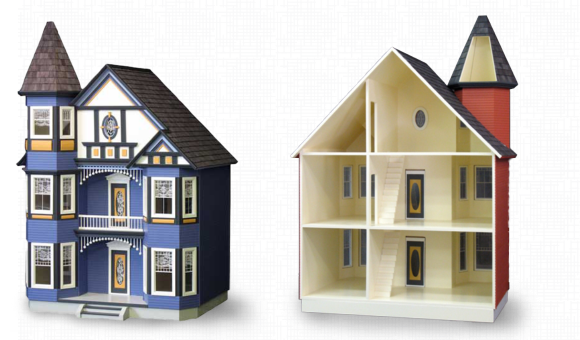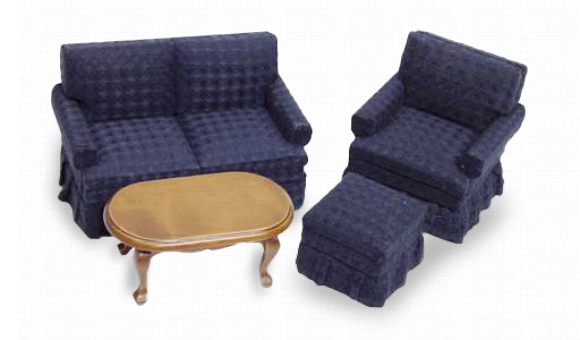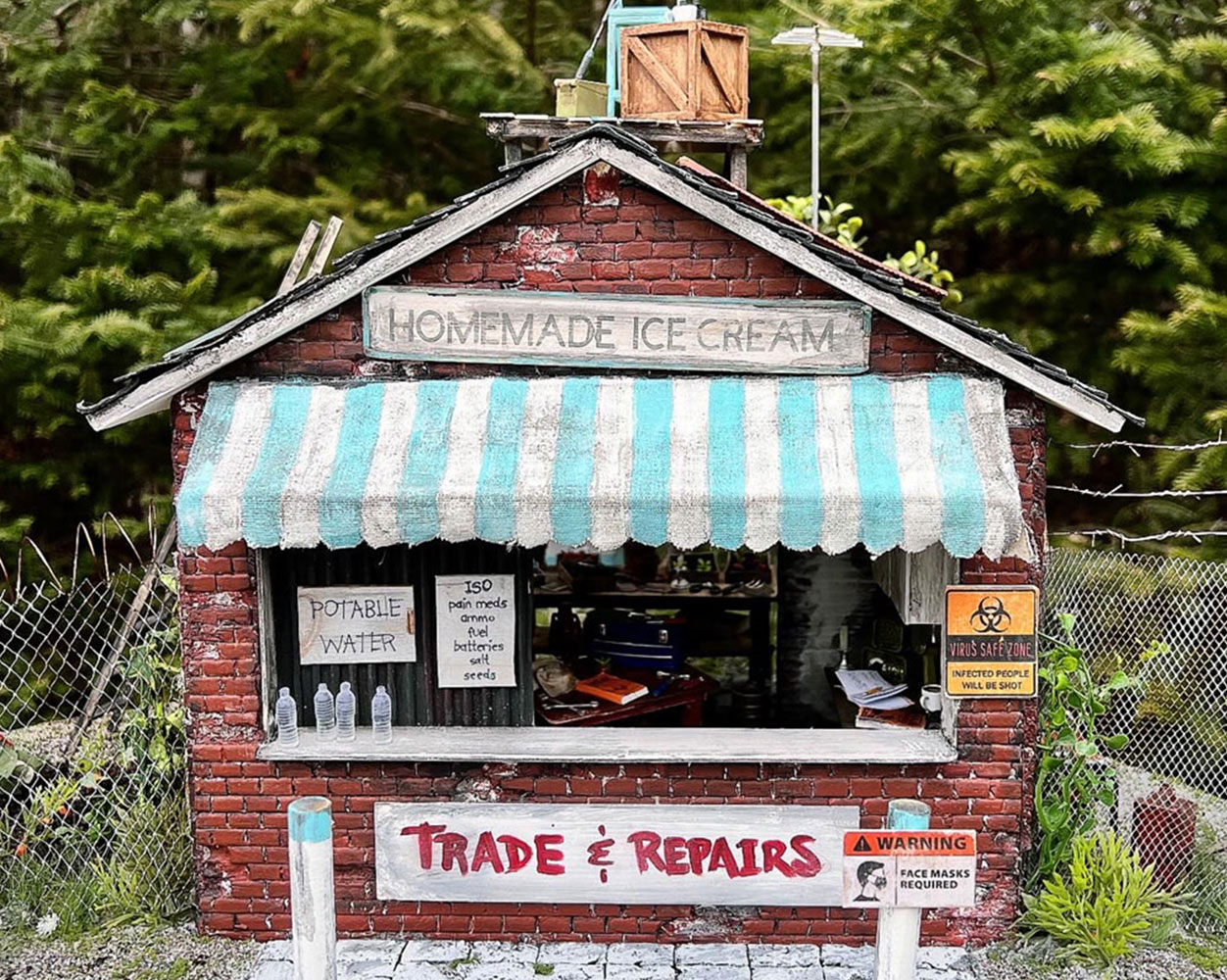There are numerous ways to paint miniature projects. The most common methods of painting miniatures are with a brush, an air brush, a spray can or a sponge brush. The following instructions and suggestions will help you get started.
Note: Whenever possible, assemble the shell of your dollhouse kit before painting. There is less chance of warping. Paint all trim, windows, doors, shutters, railings, etc. before gluing them onto the house.
General Basics for Painting Miniatures
Priming and Sealing
To prime and seal your dollhouse, first remove all the windows and doors. Then paint or spray all surfaces of the shell with a wood sealer. This will prevent finishing, paints, varnishes and wallpaper paste from being absorbed into the wood surface, as well as preventing warpage of the plywood later. If the windows and doors cannot be removed, be sure to cover them when using a spray sealer.
It is not necessary to use a wood sealer or primer on houses built of top-quality plywood or MDF. If you are not applying clapboard, start painting the main section of the house. Because the first coat tends to soak into the wood, it will probably take three applications before you are finished.
Paint the inside of the dollhouse with a flat white paint (some you may already have around the house). Flat white paint gives a better surface color for wallpaper, and sets off the true color of the background. This paint makes an excellent substitute for wood sealer and also provides a good surface for applying the tape wire when wiring the dollhouse.
Types of Paint
Use a semi-gloss latex or acrylic base paint for all painted surfaces in a dollhouse. These paints allow easier cleaning of all surfaces of the dollhouse. When dust accumulates or fingerprints appear, simply wipe clean with a damp cloth. And since latex paint is water base, brushes and paint containers will clean up with water. In addition, latex paint goes on smooth, dries fast and the second coat can be applied within a short period of time. Acrylic or latex paint are denser paints and tend to build thickness as you add coats. You will need at least two coats to cover properly, sometimes three.
Builder's Choice is a good example of a superior latex paint and is available at most miniature shops in a variety of colors and sizes. If this paint is not available, you can substitute with any good quality interior latex paint found in a paint store. You may also use an oil base semi-gloss paint, if you do not mind cleaning up with turpentine. This paint does not build thickness when using more than one coat. Oil base paints provide a beautiful finish with one coat, but take longer to dry.
Because the trim does not require much paint, you can use the acrylic paints found in most Country paint kits. Since acrylic paints have a flat finish, use a water base varnish as the last coat to give your dollhouse a semi-gloss finish. It may take two coats for a smooth finish. This water base varnish is found in the Country painting supplies.
Choosing The Colors
Color schemes and combinations are a dilemma for many people. You can research paint colors in many ways:
Look at "life size" houses for color combinations, architectural trim, roof shingle designs, etc. whenever you drive through residential communities. It is amazing how many ideas you can get. You might even take pictures of the house(s) that pique your interest.
Look in design magazines as well as architectural magazines for ideas for both the interior and exterior of your dollhouse.
If the style of your dollhouse reflects a historical period, research the colors used during that time. You will find many books on the architecture and design of homes. Two such books are Painted Ladies and Daughters of Painted Ladies. These books show many of the famous Victorian homes in California with several color combinations.
Brushes
To achieve a fine finish to the exterior of your dollhouse, the brushes you use are as important as the paint. Therefore, always work with good quality brushes that won't leave bristles in your finish. Flat cut artist's brushes with the white or synthetic bristles are superb. Note: To determine what size brush(es) you should use, choose one about the width of the wood or a little smaller. This prevents you from getting paint everywhere.
Some people prefer to use the foam brushes to paint the large flat areas. Since foam brushes pick up small particles of the wood, use a different brush for each coat of paint.
Painting
- If there is a piece of acrylic in a component, remove it before you start to paint.
- It is wise to use thinner coats of paint, so that the surface will be even. Be sure to check often for drips, runs and globs of paint on the edges on both sides of the area that you are painting.
- The first coat tends to pull out the grain of the wood, causing the necessity to sand in order to have a smooth finish. It is a good idea to sand after the application of each coat of paint. The final coat, however, does not need to be sanded.
Sanding
- Before you begin to paint, sand all rough areas of the raw wood.
- You may use #220 sandpaper, the plastic sanding pads, etc.
- An ordinary torn piece of brown paper grocery bag, wadded up, makes a great "sandpaper," even on raw wood. It will not remove the paint between coats, does not leave gouges or mar the finish, and makes unusually shaped areas easier to sand. The resulting finish is very smooth.
- Use an emery board to sand small areas or components.
- Be sure to sand between coats of paint or varnish in order to remove the grain and leave a smooth finish. This gives a more professional look to your finished product.
Staining
Oil base stains are preferred over the water base variety, because the water base stains do not penetrate as deep. They also tend to pull out the grain of the wood. Then, during the sanding process, some of the stain is removed.
- Since different woods can change the color of the stain, test for color by staining a scrap piece of wood. Remember to start light, you can always go darker.
- When applying an oil base stain with a cloth, one coat is normally sufficient. You may also apply the stain with a brush.
- Let the stain dry for at least 24 hours.
- Then sand, clean surface, and varnish two to three coats. Fast Drying Minwax Semi-Gloss Polyurethane Varnish is a good varnish, as it dries in two to three hours. If possible, let the varnished pieces dry overnight.
- Sand lightly between coats of varnish.
- Let the varnish dry completely.
- For a really nice finish, apply a light coat of furniture wax (not Pledge) and buff. This works especially well for floors.
- If you stain the wood floors in the dollhouse instead of carpeting, stain them before you apply the wallpaper.
Techniques of Painting
Clapboard
While there is no right or wrong way to paint clapboard, the most common procedure is to glue the clapboard onto the house first, and then paint it.
- When painting clapboard, use a brush the width of the clapboard. The first coat will soak in and pull out the grain of the wood.
- Sand lightly and horizontally across each section of the clapboard. Be careful not to sand the edges, as you do not want to deform or ruin the clapboard. An emery board makes an excellent tool for sanding the clapboard, because it is basically the same width as the clapboard and has a very fine grain.
- Wipe the surface clean.
- Apply the second coat of paint.
- If you still feel that the finish is not exactly as you want it to be, sand again and apply a third coat of paint.
The method outlined above will also work for dollhouses that have grooved plywood to resemble clapboard. If you want to save time in the workshop, you may paint the clapboard before attaching it to the house. Usually this is not recommended, as the clapboard is thin and may warp in the process of painting. However, it is often easier to sand and paint the individual pieces before they are attached to the house. Follow the procedure outlined below to minimize any complications (such as warping).
- You must paint both sides of the clapboard at the same time, in order to equalize the moisture.
- Paint one-third of the front and then the same one-third on the back side.
- Repeat this sequence until the entire piece of clapboard is painted.
- If it starts to turn or warp slightly, very carefully flatten the piece of clapboard and lay it out to dry.
- You only need to paint one coat on the back and two or three coats on the front. Because it is "sealed" on both sides, the clapboard will adhere to the house better and will not warp after being applied.
Windows & Doors
If the acrylic is removable, follow the procedure outlined in the General Basics Section for Painting and Staining . If the acrylic pane cannot be removed from the wood frame of the windows and doors, follow the procedure outlined below.
- Cut a piece of paper slightly larger than the window opening. Slide it under the window section.
- Using a small brush, carefully paint, stain or varnish the wood frame, pushing the paper against the edge of the wood piece. This should help you keep the paint off of the acrylic window pane.
Remember: PATIENCE IS A VIRTUE when working with miniatures. NEVER HURRY!, because "HASTE MAKES WASTE."
Working Windows
Because you can open and close them, working windows add to the overall "look" of your dollhouse. They create a sense of genuiness to the dollhouse. Be careful not to paint them shut!
- On most working windows the top of the frame is loose so that you may remove the acrylic panes for painting. If the panes are secure in the wood frame, follow Steps 1 & 2 as outlined above.
- Paint the outside frame by following the directions in the General Basics Painting Section.
- Be careful not to apply the paint too heavily in the grooves where the panes slide up and down. There is very little tolerance here. The goal for these areas is twofold: (1) to give the illusion of color, and (2) to seal the wood. Thin the paint before you apply it, so that it will not build up.
- If the window panes fit too tightly, sand the groove area lightly and carefully, so that the windows will go in and slide up and down. You might also have to sand the edges of the window pane frames.
- Use WD-40® on the frames, and the panes will slide up and down easier. After you have placed the window panes in the frame to your satisfaction, glue the top piece in place.
Individual Pieces of a Dollhouse
When it is necessary to paint an individual piece (wall, roof, floor, etc.) of a dollhouse before assembly, follow the instructions in the Clapboard Painting section (above) of this chapter. It is important to paint both sides of piece at the same time. Painting a piece of wood under 1/2" thick on one side will cause it to warp. This is especially true of plywood pieces, because they are constructed of thin pieces of wood stacked with a filler and do not have the density of solid wood.
Porch & Stair Accessories
It is easier to paint small parts such as spindles, railings and post, with an aerosol paint can or an air brush. However, you can also hand paint them with a brush.
- To prepare for spraying, use a small dot of hot glue or rubber cement on a piece of wood or cardboard, and position the spindles about 1" apart. This allows easy removal of the small pieces once they dry.
- Spray with a light coat, let dry, sand and spray another light coat. Repeat until the finish is the way you want it.
- When you are painting more than one color on the spindle, hand paint the other colors using a small brush. This is a tedious job and will require touching up now and then. On these additional colors, you will need more than one coat.
- A styrofoam egg carton makes a superb foundation for finishing the spindles. Place double-faced carpet tape on the flat-top portion of the egg carton. Then set the spindles on end on the carpet tape as they are painted to let them dry. The egg carton method is also good to use when you are painting metal miniatures.
- If you have used flat paints, apply a water base varnish for the semi-gloss finish. The railings and porch posts can be sprayed or hand painted in the same manner. Paint the stair treads on both sides at once so they will not warp. The top side will probably need two to three coats of paint. Sand between coats for a smooth finish.



